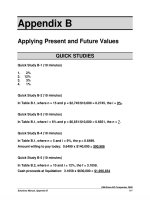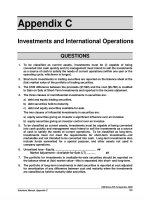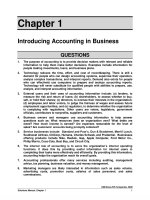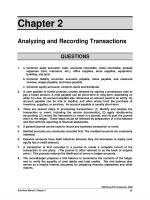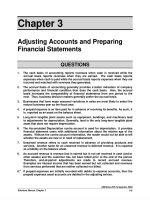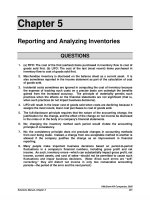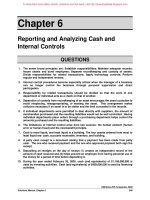Solution manual financial accounting by valix ch6 10
Bạn đang xem bản rút gọn của tài liệu. Xem và tải ngay bản đầy đủ của tài liệu tại đây (232.18 KB, 72 trang )
72
CHAPTER
6
Problem 6-1
Problem 6-2
1.
2.
3.
4.
5.
1.
2.
3.
4.
5.
C
C
C
A
C
6.
7.
8.
9.
10.
B
C
B
A
C
C
D
C
C
B
6.
7.
8.
9.
10.
A
B
B
B
D
Problem 6-3
March 1 Cash
April
2,000,000
Note payable – bank
1 Cash
Sales discount
Accounts receivable
2,000,000
980,000
20,000
1,000,000
June 1 Cash
2,000,000
Accounts receivable
2,000,000
Sept. 1 Note payable – bank
Interest expense (12% x 2,000,000 x 6/12)
Cash
2,000,000
120,000
2,120,000
Problem 6-4
Requirement 1
2008
Oct. 1 Cash
Discount on note payable (10% x 4,000,000)
Note payable – bank
1 Interest expense (400,000 x 3/12)
Discount on note payable
2009
Oct. 1 Note payable – bank
Cash
3,600,000
400,000
4,000,000
100,000
100,000
4,000,000
4,000,000
Dec. 31 Interest expense
Discount on note payable
300,000
300,000
Requirement 2
Current liabilities:
Note payable – bank (Note 3)
Discount on note payable
( 300,000)
Carrying value
4,000,000
3,700,000
73
Note 3 – Note payable – bank
Accounts of P5,000,000 are pledged to secure the bank loan of P4,000,000.
Problem 6-5
May 1 Accounts receivable – assigned
Accounts receivable
800,000
1 Cash (640,000 – 20,000)
Service charge
Note payable – bank
620,000
20,000
800,000
640,000
5 Sales return
Accounts receivable – assigned
30,000
30,000
10 Cash
Sales discount (2% x 500,000)
Accounts receivable – assigned
500,000
490,000
June 1 Note payable – bank
Interest expense (2% x 640,000)
Cash
490,000
12,800
7 Allowance for doubtful accounts
Accounts receivable – assigned
20 Cash
July
Accounts receivable – assigned
1 Note payable – bank (640,000 – 490,000)
Interest expense (2% x 150,000)
Cash
1 Accounts receivable
Accounts receivable – assigned
Accounts receivable – assigned
Less: Collections
Sales discount
Sales return
Worthless accounts
Balance
10,000
502,800
10,000
10,000
200,000
200,000
150,000
3,000
153,000
60,000
60,000
800,000
690,000
10,000
30,000
10,000
740,000
60,000
Problem 6-6
July 1 Accounts receivable – assigned
Accounts receivable
1,500,000
1,500,000
74
July 1 Cash (1,125,000 – 60,000)
Service charge (4% x 1,500,000)
Note payable – bank
Aug. 1 Note payable – bank
Accounts receivable – assigned
800,000
1,065,000
60,000
1,125,000
800,000
1 Interest expense (2% x 1,125,000)
Cash
22,500
Sept. 1 Cash
Interest expense
Note payable – bank
Accounts receivable – assigned
500,000
168,500
6,500
325,000
Accounts receivable
Accounts receivable – assigned
200,000
200,000
Collections by bank
Less: Payment of loan (1,125,000 – 800,000)
325,000
Excess collection
Less: Interest (2% x 325,000)
6,500
Cash remittance from bank
22,500
500,000
175,000
168,500
Problem 6-7
July 1 Accounts receivable – assigned
Accounts receivable
500,000
1 Cash (400,000 – 10,000)
Service charge (2% x 500,000)
Note payable – bank
390,000
10,000
Aug. 1 Cash
400,000
330,000
Accounts receivable – assigned
1 Interest expense (1% x 400,000)
Note payable – bank
Cash
Sept. 1 Cash
500,000
Accounts receivable – assigned
1 Interest expense (1% x 74,000)
Note payable – bank
Cash
330,000
4,000
326,000
330,000
170,000
170,000
740
74,000
74,740
75
Problem 6-8
Requirement a
Dec. 1 Accounts receivable – assigned
Accounts receivable
1 Cash
Service charge
Note payable – bank
31 Cash
Sales discount
Accounts receivable – assigned
31 Interest expense (1% x 1,300,000)
Note payable – bank
Cash
1,500,000
1,250,000
50,000
970,000
30,000
1,500,000
1,300,000
1,000,000
13,000
957,000
970,000
Requirement b
The accounts receivable – assigned with a balance of P500,000 should be classified
as current asset and included in trade and other receivables.
The note payable – bank of P343,000 should be classified and presented as a current
liability.
The company should disclose the equity in assigned accounts as follows:
Accounts receivable – assigned
500,000
Note payable – bank
(343,000)
Equity in assigned accounts
157,000
Problem 6-9
July
1 Accounts receivable – assigned
Accounts receivable
800,000
1 Cash (640,000 – 24,000)
Service charge (3% x 800,000)
Note payable – bank
616,000
24,000
Aug. 1 Interest expense (1% x 640,000)
Note payable – bank
Accounts receivable – assigned
420,000
Sept. 1 Cash
Interest expense
Note payable – bank
800,000
640,000
6,400
413,600
2,264
226,400
91,336
Accounts receivable – assigned
320,000
76
Accounts receivable
Accounts receivable – assigned
60,000
60,000
Bank loan
August 1 payment
Balance
320,000
Collections by bank
Less: Payment of loan
Interest (1% x 226,400)
228,664
640,000
413,600
226,400
226,400
2,264
Remittance from bank
91,336
Problem 6-10
Cash
Allowance for doubtful accounts
Loss on factoring
Accounts receivable
400,000
30,000
70,000
500,000
Problem 6-11
Cash
Receivable from factor
Allowance for bad debts
Loss on factoring
Accounts receivable
5,000,000
300,000
250,000
450,000
6,000,000
Problem 6-12
Feb. 1 Cash
Service charge (5% x 800,000)
Receivable from factor (10% x 800,000)
Accounts receivable
680,000
40,000
80,000
15 Sales return and allowances
Receivable from factor
20,000
28 Cash (80,000 – 20,000)
Receivable from factor
60,000
800,000
20,000
60,000
Problem 6-13
June 1 Accounts receivable
Sales
500,000
500,000
77
June 3 Cash
Sales discount (2% x 500,000)
Commission (5% x 500,000)
Receivable from factor (25% x 500,000)
Accounts receivable
340,000
125,000
10,000
25,000
500,000
9 Sales return and allowances
Sales discount (2% x 50,000)
1,000
Receivable from factor
49,000
50,000
11 No entry
15 Cash (125,000 – 49,000)
Receivable from factor
76,000
76,000
Problem 6-14
July 26 Cash
Commission (5% x 1,000,000)
Receivable from factor (20% x 1,000,000)
Accounts receivable
July 28 Sales return and allowances
Receivable from factor
50,000
Aug. 31 Cash
Receivable from factor
750,000
50,000
200,000
1,000,000
50,000
150,000
150,000
Problem 6-15
1. Cash
Service charge (5% x 200,000)
Receivable from factor (20% x 200,000)
Accounts receivable
150,000
10,000
40,000
2. Accounts receivable – assigned
Accounts receivable
300,000
Cash
Service charge (5% x 300,000)
Note payable – bank
225,000
15,000
3. Doubtful accounts
Allowance for doubtful accounts
200,000
300,000
240,000
35,000
35,000
Required allowance (5% x 1,300,000)
Less: Allowance – January 1
Doubtful accounts
65,000
30,000
35,000
78
4. The net realizable value of the accounts receivable is included in trade and other
receivables and presented as current asset.
Accounts receivable – unassigned
1,000,000
Accounts receivable – assigned
Total
1,300,000
Less: Allowance for doubtful accounts
Net realizable value
1,235,000
300,000
65,000
The receivable from factor of P40,000 is also included in trade and other receivables.
The note payable – bank of P240,000 is classified and presented as current liability.
However, the company should disclose the equity in assigned accounts as follows:
Accounts receivable – assigned
Note payable – bank
Equity in assigned accounts
300,000
(240,000)
60,000
Problem 6-16
Books of Motorway Company
1. Cash
Receivable from factor
Allowance for doubtful accounts
Loss on factoring
Accounts receivable
2,250,000
300,000
100,000
350,000
3,000,000
Gross amount
Holdback (10% x 3,000,000)
Commission (15% x 3,000,000)
Cash received
(
(
Sales price (3,000,000 x 85%)
Book value of accounts receivable (3,000,000 – 100,000)
2,900,000
Loss on factoring
2. Cash
Receivable from factor
Accounts receivable factored
Collections by factor
3,000,000
300,000)
450,000)
2,250,000
2,250,000
( 350,000)
250,000
250,000
3,000,000
2,500,000
Balance – December 31
500,000
Receivable from factor per book
Required holdback (10% x 500,000)
Remittance from factor
300,000
50,000
250,000
79
Books of Freeway Company (factor)
1. Accounts receivable
Cash
Clients retainer
Commission income
3,000,000
2. Cash
Accounts receivable
2,500,000
3. Clients retainer
Cash
4. Doubtful accounts
Allowance for doubtful accounts (4% x 500,000)
2,250,000
300,000
450,000
2,500,000
250,000
250,000
20,000
20,000
Problem 6-17
Jan. 15 Notes receivable
Sales
500,000
Feb. 15 Cash
Interest expense
Notes receivable discounted
496,875
3,125
500,000
500,000
Principal
Interest (500,000 x 12% x 6/12)
Maturity value
Discount (530,000 x 15% x 5/12)
Net proceeds
July 15 Notes receivable discounted
Notes receivable
500,000
500,000
30,000
530,000
33,125
496,875
500,000
Problem 6-18
March 14 Accounts receivable
Sales
2,050,000
2,050,000
April
2,000,000
7 Notes receivable
Freight out
50,000
Accounts receivable
2,050,000
April 20 Cash
2,000,000
Notes receivable discounted
2,001,750
Interest income
1,750
80
40,000
38,250
June 4
Principal
Add: Interest (2,000,000 x 12% x 60/360)
2,000,000
Maturity value
Less: Discount (2,040,000 x 15% x 45/360)
2,040,000
Net proceeds
2,001,750
Accounts receivable (2,040,000 + 10,000)
Cash
Notes receivable discounted
Notes receivable
July
4
Cash
20,000
Accounts receivable
Interest income (2,000,000 x 12% x 30/360
2,050,000
2,050,000
2,000,000
2,000,000
2,070,000
2,050,000
Problem 6-19
Requirement a
April 5 Notes receivable
Accounts receivable
19 Cash
500,000
500,000
501,075
Notes receivable discounted
Interest income
500,000
Principal
Add: Interest (500,000 x 12% x 60/360)
Maturity value
500,000
10,000
1,075
510,000
Less: Discount (510,000 x 14% x 45/360)
Net proceeds
8,925
501,075
May 3 Notes receivable
Accounts receivable
16 Cash
1,000,000
995,000
1,000,000
Interest expense
Notes receivable discounted
5,000
1,000,000
Principal
Less: Discount (1,000,000 x 12% x 15/360)
5,000
1,000,000
Net proceeds
May 25 Notes receivable
Interest income
Accounts receivable
995,000
1,500,000
4,500
1,504,500
81
30,000
25,500
Principal
Add: Interest (1,500,000 x 12% x 60/360)
1,500,000
Maturity value
Less: Discount (1,530,000 x 12% x 50/360)
1,530,000
Net credit
1,504,500
June 7 Accounts receivable (510,000 + 20,000)
Cash
Notes receivable discounted
Notes receivable
15 Notes receivable
Sales
June 18 Cash
2,650
Accounts receivable
Interest income (530,000 x 12% x 15/360)
530,000
530,000
500,000
500,000
800,000
800,000
532,650
530,000
Requirement b – Adjustments on June 30
1. Accrued interest receivable
Interest income (800,000 x 12% x 15/360)
4,000
4,000
Accrued interest on D’s note.
2. Notes receivable discounted
Notes receivable
1,000,000
1,000,000
To cancel the contingent liability on B’s note. This note matured on May 31.
Since there is no notice of dishonor it is assumed that the said note is paid on
the date of maturity.
Problem 6-20
May
1 Notes receivable
Accounts receivable
200,000
200,000
1 Notes receivable
Accounts receivable
July 30 Accounts receivable
Notes receivable
Interest income (200,000 x 12% x 90/360)
6,000
Aug. 1 Cash
300,000
Note receivable discounted
300,000
300,000
206,000
200,000
306,075
Interest income
6,075
82
Principal
Interest (300,000 x 12% x 6/12)
Maturity value
Less: Discount (318,000 x 15% x 3/12)
Net proceeds
Sept. 1 Notes receivable
Accounts receivable
Interest income
12,000
28 Cash
4,120
Accounts receivable
Interest income (206,000 x 12% x 60/360)
300,000
18,000
318,000
11,925
306,075
132,000
120,000
210,120
206,000
Oct. 1 Notes receivable
Sales
500,000
Nov. 1 Accounts receivable (318,000 + 12,000)
Cash
330,000
Notes receivable discounted
Notes receivable
Dec. 30 Cash
500,000
330,000
300,000
300,000
515,000
Notes receivable
Interest income (500,000 x 12% x 90/360
500,000
15,000
31 Cash
6,600
Accounts receivable
Interest income (330,000 x 12% x 2/12)
Problem 6-21
2008
336,600
330,000
Jan. 1 Cash
Notes receivable
Land
Gain on sale of land
1,000,000
6,000,000
Dec. 31 Accrued interest receivable
Interest income (12% x 6,000,000)
720,000
2009
Dec. 31 Accrued interest receivable
Interest income (12% x 6,720,000)
806,400
2010
Jan. 1 Cash
5,000,000
2,000,000
720,000
806,400
7,526,400
Notes receivable
Accrued interest receivable
6,000,000
1,526,400
83
Problem 6-22
Jan. 1 Notes receivable
Sales
Unearned interest income
600,000
Dec. 31 Cash
200,000
Notes receivable
31 Unearned interest income
Interest income
30,000
Year
2009
2010
200,000
30,000
Notes receivable Fraction
Interest income
600,000
6/12
2008
30,000
540,000
60,000
400,000
200,000
1,200,000
4/12
2/12
20,000
10,000
60,000
Problem 6-23
Face value
Present value (300,000 x 2.4018)
Unearned interest income
900,000
720,540
179,460
Jan. 1 Cash
Notes receivable
Sales
Unearned interest income
Present value
Cash received
Sales price
Cost of generator
Gross income
720,540
100,000
820,540
700,000
120,540
100,000
900,000
820,540
179,460
Dec. 31 Cash
300,000
Notes receivable
31 Unearned interest income
Interest income
Date
value
Jan. 1, 2008
Dec. 31, 2008
Dec. 31, 2009
Dec. 31, 2010
Collection
300,000
300,000
300,000
300,000
86,465
86,465
Interest
Principal
86,465
60,841
32,154
213,535
239,159
267,846
Present
720,540
507,005
267,846
-
84
Problem 6-24
Requirement 1
12/31/2008
505,000
12/31/2009
Note receivable
Sales (500,000 x 3.99)
Unearned interest income
2,500,000
Cash
Note receivable
500,000
Unearned interest income
Interest income (8% x 1,995,000)
159,600
1,995,000
500,000
159,600
Requirement 2
Note receivable (2,500,000 – 500,000)
2,000,000
Unearned interest income (505,000 – 159,600)
Book value – 12/31/2009
(
345,400)
1,654,600
Requirement 3
Interest income for 2010 (8% x 1,654,600)
132,368
Problem 6-25
Face value of note
Present value (400,000 x .7118)
Unearned interest income
400,000
284,720
115,280
Present value
Cash received
Sales price
Book value
Gain on sale
284,720
125,000
409,720
350,000
59,720
2008
Jan. 1 Cash
Notes receivable
Accumulated depreciation
Equipment
Gain on sale of equipment
Unearned interest income
125,000
400,000
150,000
Dec. 31 Unearned interest income
Interest income
Date
Jan. 01, 2008
284,720
Dec. 31, 2008
318,886
Dec. 31, 2009
357,152
Dec. 31, 2010
Interest income
34,166
34,166
Unearned interest Present value
115,280
34,166
81,114
38,266
42,848
42,848
2009
Dec. 31 Unearned interest income
Interest income
38,266
2010
Dec. 31 Unearned interest income
Interest income
42,848
2011
Jan. 1 Cash
500,000
59,720
115,280
Notes receivable
-
400,000
38,266
85
42,848
400,000
400,000
Problem 6-26
1/1/2008
Note receivable
Loss on sale of land
Land
Unearned interest income
9,000,000
250,000
7,000,000
2,250,000
PV of note (9,000,000 x .75)
Carrying amount of land
Loss on sale
12/31/2008
675,000
12/31/2009
742,500
12/31/2010
6,750,000
7,000,000
( 250,000)
Unearned interest income
Interest income (10% x 6,750,000)
675,000
Unearned interest income
Interest income (10% x 7,425,000)
742,500
Unearned interest income
832,500
Interest income (2,250,000 – 1,417,500)
1/1/2011
Cash
Note receivable
832,500
9,000,000
9,000,000
Problem 6-27 Answer C
Note payable
Discount on note payable (1,000,000 x 10.8%)
Net proceeds
1,000,000
( 108,000)
892,000
Discount on note payable
Amortization from August 1 to December 31 (108,000 x 5/12)
Balance – December 31, 2008
Note payable
Discount on note payable
Carrying value
937,000
108,000
( 45,000)
63,000
1,000,000
( 63,000)
Problem 6-28
Question 1 – Answer A
Question 2 - Answer B
86
Problem 6-29 Answer A
Problem 6-30 Answer C
Principal
Problem 6-31 Answer C
500,000
Principal
Add: Interest (500,000 x 8%)
40,000
Maturity value
540,000
10,000
Less: Discount
190,000
(540,000 x 10% x 6/12)
27,000
Net proceeds
513,000
200,000
Less: Discount
(200,000 x 10% x 6/12)
Net proceeds
Problem 6-32 Answer A
Principal
Interest (4,000,000 x 12% x 90/360)
120,000
Maturity value
4,120,000
Less: Discount (4,120,000 x 15% x 60/360)
103,000
Net proceeds
Principal
Interest revenue
Problem 6-33 Answer C
4,000,000
4,017,000
4,000,000
17,000
Problem 6-34 Answer B
Principal
600,000 Note receivable – June 30, 2007
1,500,000
Add: Interest
Less: Payment on July 1, 2008
500,000
(600,000 x 10% x 6/12)
30,000
Balance – July 1, 2008
1,000,000
Maturity value
630,000
Less: Discount
Accrued interest from July 1, 2008
(630,000 x 12% x 4/12)
25,200
to June 30, 2009 (1,000,000 x 8)
80,000
Net proceeds
604,800
Problem 6-35 Answer C
Problem 6-36 Answer A
First payment on January 1, 2008
Present value of remaining six payments (600,000 x 4.36)
2,616,000
Correct sales revenue
3,216,000
Problem 6-37 Answer D
600,000
Problem 6-38 Answer C
Note receivable
1,000,000 The note receivable is shown at its value on
Unearned interest income
( 435,000) December 31, 2008.
Carrying value equal to present
value (100,000 x 5.65)
565,000 Face value – remaining nine
payments (500,000 x 9)
4,500,000
Present value (500,000 x 6.25)
3,125,000
Unearned interest income
1,375,000
87
Problem 6-39
1. Answer C
Note receivable
Present value of note receivable (6,000,000 x .75)
4,500,000
Unearned interest income
Interest income:
2008 (10% x 4,500,000)
450,000
2009 (10% x 4,950,000)
495,000
2010 (1,500,000 – 450,000 – 495,000)
555,000
Total
2. Answer D
6,000,000
1,500,000
1,500,000
Present value of note receivable
Carrying amount of equipment
Loss on sale of equipment
4,500,000
4,800,000
( 300,000)
Problem 6-40 Answer B
Present value of note receivable (1,000,000 x .712)
712,000
Book value of equipment
Loss on sale
800,000
( 88,000)
Interest income for first year (12% x 712,000)
85,440
Problem 6-41 Answer D
NR from Hart
1,000,000
NR from Maxx (1,150,000 x .68)
782,000
88
CHAPTER 7
Problem 7-1
Problem 7-5
1.
2.
3.
4.
5.
6.
7.
8.
9.
10.
D
B
D
D
D
D
C
A
A
A
1.
2.
3.
4.
5.
6.
7.
8.
9.
10.
Problem 7-2
D
D
A
C
D
A
D
A
A
B
1. B
2. A
3. A
4. C
5. C
6. D
7. C
8. A
9. A
10. D
Problem 7-3
1.
2.
3.
4.
5.
6.
7.
8.
9.
10.
D
C
C
A
A
C
A
C
A
C
Problem 7-4
1. C
2. B
3. A
4. C
5. D
6. D
7. A
8. B
9. B
10. A
Problem 7-6
Items counted in the bodega
4,000,000
Items included in count specifically segregated per sales contract
( 100,000)
Items returned by customer
Items ordered and in receiving department
Items shipped today, FOB destination
Items for display
Items on counter for sale
Damaged and unsalable items included in count
Items in shipping department
250,000
50,000
400,000
150,000
200,000
800,000
( 50,000)
5,700,000
Problem 7-7
Materials
Goods in process
Finished goods in factory
Finished goods in company-owned retail store (750,000/150%)
Finished goods in the hands of consignees (400,000 x 60%)
240,000
Finished goods in transit
Finished goods out on approval
Materials in transit (330,000 + 30,000)
360,000
Correct inventory
1,400,000
650,000
2,000,000
500,000
250,000
100,000
5,500,000
Problem 7-8
Finished goods
2,000,000
Finished goods held by salesmen
Goods in process (720,000/80%)
Materials
Materials returned to suppliers for replacement
Factory supplies (110,000 + 60,000)
170,000
Correct inventory
100,000
900,000
1,000,000
100,000
4,270,000
89
Problem 7-9
1. Inventory
50,000
2. Accounts payable
75,000
50,000
Income
summary
75,000
Purchases
3. Purchases
30,000
Inventory
Income summary
4. Income summary
Inventory
5. Purchases
Accounts payable
30,000
Accounts
payable
30,000
30,000
90,000
90,000
140,000
140,000
Problem 7-10
1. EXCLUDE – The term of the shipment is FOB destination.
2. EXCLUDE – The goods are held only for consignment.
3. INCLUDE – There is no perfected sale yet as of December 31, 2008.
4. INCLUDE – The term FOB supplier’s warehouse is synonymous with FOB shipping point.
5. EXCLUDE – There is already a constructive delivery since the article was specifically
made according to the customer’s specifications and the article is already
completed on December 31, 2008.
Problem 7-11
Inventory before adjustment
Goods out on consignment
Goods purchased FOB shipping point
Goods sold FOB shipping point
Goods sold FOB destination
Goods sold FOB destination
Correct December 31 inventory
7,600,000
1,000,000
250,000
( 850,000)
260,000
840,000
9,100,000
90
Problem 7-12
Inventory per book
Item 3 (18,500 – 1,000 / 140%)
12,500
Item 4 (50,000 + 2,500)
52,500
Item 5 (35,000 / 140% = 25,000 + 2,000)
Adjusted inventory
950,000
27,000
1,042,000
Problem 7-13
Requirement a
Periodic System
1. Purchases
Accounts payable
800,000
800,000
2. Accounts payable
Purchase returns
50,000
50,000
3. Accounts payable
Cash
4. Accounts receivable
Sales
1,580,000
Perpetual System
800,000
50,000
600,000
2. Accounts payable
50,000
Merchandise inventory
600,000
3. Accounts payable
Cash
1,580,000
4. Accounts receivable
Sales
1,580,000
5. Sales return
Accounts receivable
790,000
1. Merchandise inventory
800,000
Accounts payable
40,000
40,000
600,000
600,000
1,580,000
Cost of sales
790,000
Merchandise inventory
6. Cash
1,360,000
5. Sales return
40,000
Accounts receivable
1,360,000
Accounts receivable
40,000
7. Inventory-Dec. 31
Income summary
20,000
(60 x 1,000)
60,000
60,000
Merchandise inventory
Cost of sales
20,000
6. Cash
1,360,000
Accounts receivable
1,360,000
7. Inventory shortage
10,000
Merchandise inventory
Merchandise inventory per book
Physical count
Shortage
10,000
70,000
60,000
10,000
Requirement b
Periodic System
Perpetual System
Inventory – January
90,000
Cost of sales recorded
Purchases
800,000
(790,000 – 20,000)
Purchase returns
( 50,000) 750,000
Inventory shortage
10,000
Goods available for sale
840,000
Adjusted cost of sales
780,000
Less: Inventory – December 31
60,000
Cost of sales
780,000
91
Problem 7-14
770,000
Company A
List price
Less: First trade discount (20% x 500,000)
500,000
100,000
400,000
Second trade discount (10% x 400,000)
40,000
360,000
Third trade discount (10% x 360,000)
36,000
Invoice price
Less: Cash discount (2% x 324,000)
Payment within the discount period
324,000
6,480
317,520
Company B
List price
Less: Trade discount (35% x 500,000)
175,000
Invoice price
Less: Cash discount (2% x 325,000)
Payment within the discount period
500,000
325,000
6,500
318,500
Problem 7-15
Requirement a
Gross method
1. Purchases
Accounts payable
4,655,000
2. Freight in
Cash
250,000
3. Accounts payable
Cash
1,617,000
Purchase discount
Accounts payable
Cash
Net method
4,750,000
1. Purchases
4,750,000
250,000
2. Freight in
250,000
1,650,000
1,617,000
250,000
Cash
3. Accounts payable
Cash
1,617,000
33,000
2,100,000
2,100,000
4. No entry
5. Inventory
Income summary
981,000
4,655,000
Accounts payable
Accounts payable
2,058,000
Purchase discount lost
Cash
4. Purchase discount lost
Accounts payable
(1,000,000 x 2%)
1,000,000
5. Inventory
1,000,000
42,000
2,100,000
20,000
981,000
Income summary
20,000
92
Requirement b
method
Purchases
Freight in
Total
Less: Purchase discounts
Goods available for sale
Less: Inventory – December 31
Cost of sales
Ending inventory:
Gross (5,000,000/5)
Net (4,905,000/5)
Gross method
4,750,000
250,000
5,000,000
33,000
4,967,000
1,000,000
3,967,000
Net
4,655,000
250,000
4,905,000
-___
4,905,000
981,000
3,924,000
1,000,000
981,000
Problem 7-16
Gross method
Sept. 1 Purchases
Accounts payable
650,000
1 Freight in
Accounts payable
20,000
7 Accounts payable
Purchase returns and allowances
Oct. 1 Accounts payable
Cash
650,000
20,000
10,000
10,000
660,000
660,000
Net method
Sept. 1 Purchases
Accounts payable
1 Freight in
Accounts payable
7 Accounts payable (10,000 x 98%)
Purchase returns and allowances
Oct. 1 Accounts payable (657,000 – 9,800)
Purchase discount lost (2% x 640,000)
Cash
637,000
637,000
20,000
20,000
9,800
647,200
12,800
9,800
660,000
93
Problem 7-17
Gross method
1. Merchandise inventory
Accounts payable
980,000
Net method
1,000,000
1,000,000
2. Accounts payable
Cash
50,000
50,000
3. Accounts payable
Cash
784,000
Cost of sales
800,000
4. Accounts payable
Cash
150,000
50,000
784,000
1. Merchandise inventory 980,000
Accounts payable
2. Accounts payable
Cash
50,000
3. Accounts payable
784,000
Cash (800,000 x 98%)
16,000
150,000
5. Cash
Sales
1,200,000
1,200,000
1,200,000
Cost of sales
700,000
Merchandise inventory
686,000
(1,000,000 x 70%)
700,000
4. Accounts payable
146,000
Purchase discount lost
4,000
Cash
150,000
5. Cash
1,200,000
Sales
Cost of sales
686,000
Merchandise inventory
(980,000 x 70%)
Problem 7-18
Units
Total cost
1. FIFO - periodic
Lot No. 4
50,000
5
1,305,000
2. Beginning inventory
800,000
Purchases: Lot No. 1
200,000
880,000
720,000
Unit cost
500
100
14,500
90
15,000
1,355,000
10,000
80
2,000
100
2
8,000
110
3
6,000
120
4
9,500
100
14,500
90
950,000
5
1,305,000
Goods available for sale
50,000
Weighted average (4,855,000/50,000)
15,000
3. Specific identification
4,855,000
97.10
1,456,500
Lot 3
4
6,000
9,000
15,000
Goods available
of sales
FIFO
3,500,000
Weighted average
3,398,500
Specific identification
3,235,000
120
100
720,000
900,000
1,620,000
Inventory-Dec. 31
4,855,000
1,355,000
4,855,000
1,456,500
4,855,000
1,620,000
Cost
94
Problem 7-19
Total cost
FIFO
December 17
450,000
22
860,000
Units
Unit cost
10,000
45
20,000
43
30,000
1,310,000
Average method
December 1
520,000
7
17
22
860,000
Available for sale
5,580,000
Inventory (5,580,000/120,000)
10,000
30,000
60,000
20,000
52
50
45
43
1,500,000
2,700,000
120,000
30,000
Goods available for sale
5,580,000
Less: Inventory – December 31
1,395,000
Cost of goods sold
4,185,000
46.50
1,395,000
FIFO
5,580,000
Average
1,310,000
4,270,000
Problem 7-20
The stock cards are not prepared anymore. The end results are simply given.
Total cost
FIFO
Ending inventory
Units
4,000
Unit cost
210
840,000
Cost of sales
Average method
Ending inventory
2,700,000
4,000
252.50
1,010,000
Cost of sales
2,530,000
Problem 7-21
Purchases
2006
5,000
2007
9,000
2008
15,000
Total inventory – December 31, 2008 (units)
Sales
Sales
Cost of sales:
Inventory – December 31, 2007 (3,000 x 60)
Purchases
Goods available for sale
Less: Inventory – December 31, 2008 (6,000 x 75)
855,000
Gross income
Inventory increment
4,000
1,000
7,000
2,000
12,000
3,000
6,000
1,200,000
180,000
1,125,000
1,305,000
450,000
345,000
95
Problem 7-22
Units
Unit cost
Total cost
FIFO
October 1
15,000
60
900,000
Weighted average – periodic
January 1
April
1
October 1
Goods available for sale
Less: Sales
Ending inventory
10,000
15,000
25,000
50,000
35,000
15,000
40
50
60
400,000
750,000
1,500,000
2,650,000
Weighted average (2,650,000/50,000)
15,000
53
795,000
cost
Moving average – perpetual
January 1
31
( 200,000)
Balance
200,000
April 1
750,000
Total
950,000
Units
Unit cost
10,000
( 5,000)
5,000
400,000
40
40
15,000
20,000
40
Total
50
47.50

